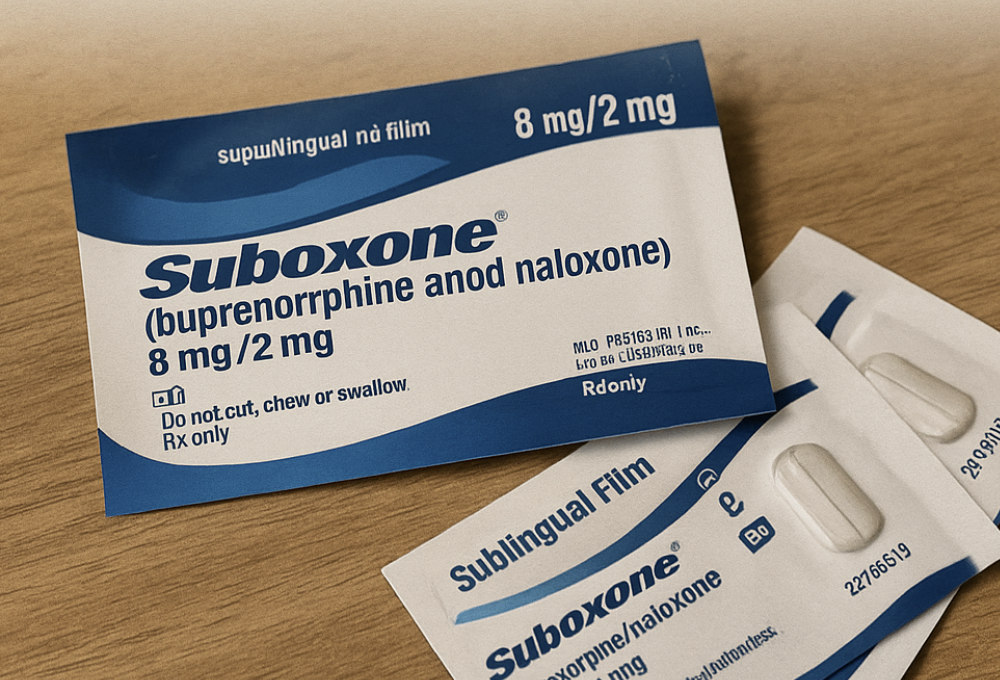Suboxone is taken as sublingual tablets, sublingual films, or buccal films. This article explains how Suboxone is taken in each form to ensure it works effectively.
Key Takeaways
- Suboxone is available in three primary forms: sublingual tablets, sublingual films, and buccal films, each with specific administration methods that affect effectiveness.
- Proper adherence to dosage timing and administration guidelines, including avoiding food and drink before taking Suboxone, is crucial for maximizing its efficacy and minimizing the risk of misuse.
- Different populations, such as pregnant women, the elderly, and children, require specific considerations and monitoring when using Suboxone to ensure safety and effectiveness.
Overview of Suboxone Dosage Forms
Suboxone is available in several forms, each designed to cater to different preferences and needs. The primary forms include sublingual tablets, sublingual films, and buccal films, each offering unique benefits and methods of administration.
Knowing these forms helps anyone beginning Suboxone treatment, as the choice can affect the medication’s effectiveness and ease of use.
Sublingual Tablets
Sublingual tablet is one of the most common forms of Suboxone, specifically designed for quick absorption through the oral mucosa. To take Suboxone sublingual tablets, place the tablet under your tongue and allow it to dissolve completely without chewing, swallowing, or crushing it.
This approach ensures predictable dosing and enhances the medication’s efficacy, making it a preferred medication-assisted treatment used to treat Suboxone addiction.
Sublingual Films
Sublingual film is another popular form of Suboxone, offering a more discreet and potentially faster onset of effects compared to tablets. Place the film under your tongue and wait for it to dissolve fully, avoiding swallowing until it’s completely dissolved.
Its ease of use and quicker absorption make it an effective alternative for those who struggle with tablets.
Buccal Film (Film placed between the cheek and gums)
Buccal films offer an alternative by placing the film between the cheek and gums until it fully dissolves, beneficial for patients who find other forms less preferable.
Buccal films may also cause less irritation to the oral mucosa, making them a comfortable option for many users.

Key Considerations for Proper Use of Suboxone
Proper use of Suboxone requires understanding the following:
- Timing
- Absorption
- Interaction with food and drink
- Avoiding misuse to ensure its effectiveness
Adhering to the prescribed schedule, ensuring proper dissolution, and being mindful of food and drink before and after taking Suboxone can significantly impact its efficacy.
Additionally, the combination of buprenorphine and naloxone in Suboxone plays a vital role in minimizing misuse and overdose risks, making it a safer option for treating opioid addiction, as buprenorphine binds to opioid receptors.
Dosage Timing
Start taking suboxone as prescribed, typically once a day, is essential for maintaining its effectiveness and preventing withdrawal symptoms. Starting suboxone or missing a suboxone dose or taking extra doses can lead to significant risks, including potential relapse or overdose.
Adhering to the prescribed schedule helps manage maintenance treatment more effectively and achieve better outcomes.
Absorption and Effectiveness
Suboxone needs to dissolve under the tongue or in the cheek to ensure maximum absorption. This process allows buprenorphine and naloxone to be effectively absorbed through the mucous membranes, enhancing their effectiveness in treating opioid addiction.
Proper absorption is essential for the medication to reduce withdrawal symptoms and cravings effectively.
Food and Drink
Avoid eating or drinking immediately before taking Suboxone, as food and drink can interfere with the medication’s absorption. Wait until the tablet or film has completely dissolved before consuming anything.
Drinking water after the medication has dissolved can help ensure proper hydration and comfort. It is important to drink water to maintain overall health.
Avoiding Misuse
The combination of buprenorphine and naloxone in Suboxone helps minimize the risk of misuse and overdose by creating a ceiling effect that limits the drug’s potential for abuse. Proper usage prevents misuse and ensures the medication’s safety and effectiveness in treating opioid addiction.
Special Considerations for Different Populations
Different populations, including pregnant women, the elderly, and children/adolescents, have unique guidelines for Suboxone use. These guidelines ensure safe and effective use of the medication, considering the specific needs and risks of each group.
Suboxone in Pregnant Women
Suboxone has been shown to be a safe and effective treatment for opioid use disorder in pregnant women, leading to improved maternal and neonatal health outcomes. Research shows that using buprenorphine-naloxone during pregnancy does not significantly increase the risk of congenital anomalies compared to other opioid treatments.
However, it can lead to neonatal withdrawal syndrome, so careful monitoring and consultation with healthcare providers are essential when using Suboxone during pregnancy.

Suboxone for the Elderly
Elderly patients may require adjustments in Suboxone dosages due to changes in metabolism and the presence of comorbidities. It is crucial for healthcare providers to monitor elderly patients closely for adverse effects and interactions with other medications.
This population may also require careful monitoring for signs of overdose due to age-related factors.
Children and Adolescents
Medical supervision is crucial when prescribing Suboxone to children and adolescents, as their responses may vary significantly from adults. Pediatric dosing guidelines necessitate careful consideration of the child’s weight, age, and overall health.
Strict control and monitoring by healthcare professionals, including doctors, ensure the safety and effectiveness of Suboxone in younger patients.
What to Do If You Miss a Dose
If you miss a dose of Suboxone, take it as soon as you remember, but do not take two doses at once. If it’s almost time for your next dose, skip the missed one and continue with your regular schedule.
Regularly missing doses may require consulting a healthcare professional to adjust your treatment plan and provide additional support in your recovery.
Guidance on Missed Doses
If a missed dose is taken within 24 hours, take it as soon as possible, but avoid taking two doses together.
If multiple doses are missed, consult your doctor before resuming medication to avoid withdrawal symptoms and ensure safe continuation of treatment.
Side Effects of Suboxone When Taken Correctly
Suboxone can lead to both mild and severe side effects when used as directed. Monitoring and managing these side effects is crucial for anyone taking Suboxone.
Common Side Effects
Common side effects of Suboxone include dry mouth, headache, constipation, and nausea. Suboxone side effects also frequently include anxiety, insomnia, and gastrointestinal issues reported among users.
Managing these effects involves staying hydrated, maintaining a balanced diet, and consulting your healthcare provider if symptoms persist.
Severe Side Effects
Severe side effects of Suboxone, although rare, require immediate medical attention. These include severe allergic reactions, breathing complications, and liver damage. Long-term use may lead to hormonal imbalances and respiratory depression.
Recognizing these symptoms early and responding promptly can prevent life-threatening conditions.
Alternatives to Suboxone Administration
There are several FDA-approved Suboxone alternatives for treating opioid use disorder, including Methadone and Naltrexone. Knowing these alternatives and how they compare to Suboxone can help patients and healthcare providers choose the best treatment option.
Methadone vs. Suboxone
Methadone, a long-acting opioid agonist, is typically administered once daily in specialized clinics, offering flexible dosing options that aid in adherence to treatment. Long acting opioids, such as Suboxone, taken sublingually, can be prescribed without direct supervision and are generally less addictive due to their ceiling effect.
Each medication has its advantages and disadvantages, and the choice often depends on individual patient needs and treatment goals.
Naltrexone vs. Suboxone
Naltrexone, an opioid antagonist, blocks the effects of opioids and is administered either orally or via injection. Unlike Suboxone, Naltrexone does not suppress cravings and must be initiated after a period of opioid abstinence. It removes the risk of opioid dependence, making it a viable alternative for some patients.
Bottom Line: How is Suboxone Taken
Proper usage of Suboxone is critical for treating opioid addiction effectively. Following medical instructions, understanding the forms of Suboxone, and being aware of the needs of different populations can significantly improve treatment outcomes.
Always consult your healthcare provider for any concerns and adhere to the prescribed guidelines to maximize the benefits of Suboxone.
FAQs About Suboxone Dose
What happens if I accidentally swallow Suboxone?
If you accidentally swallow Suboxone, it may not be as effective because it needs to dissolve under the tongue or in the cheek for proper absorption. Swallowing it can reduce its efficacy in treating opioid addiction.
Can I drink alcohol while taking Suboxone?
It is highly recommended to avoid drinking alcohol while taking Suboxone, as it can increase the risk of severe side effects such as respiratory depression.
How long does Suboxone stay in the system?
Suboxone can stay in your system for several days. The exact duration depends on various factors, including metabolism, dosage, and frequency of use. Learn more about how long Suboxone stays in your system.
Can Suboxone be taken with other medications?
Suboxone can interact with other medications, so it is crucial to inform your healthcare provider about all the medications you are taking to avoid potential adverse interactions.
What should I do if I experience severe side effects from Suboxone?
If you experience severe side effects such as trouble breathing, severe dizziness, or signs of an allergic reaction, seek immediate medical attention.















